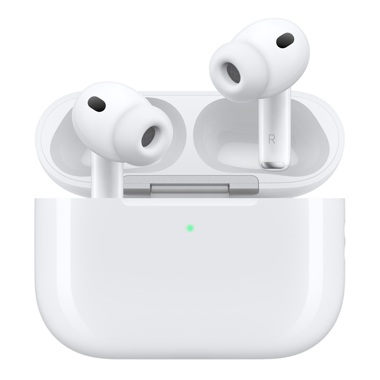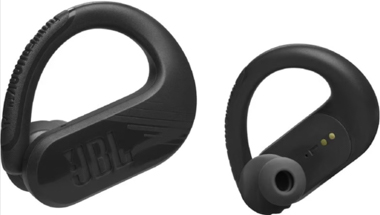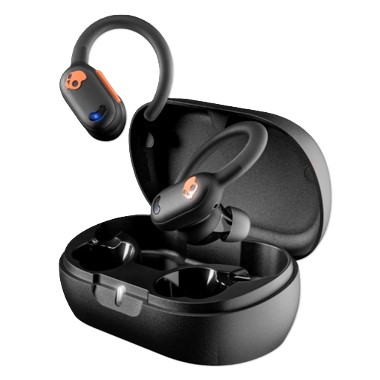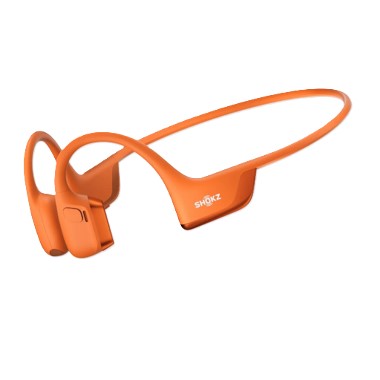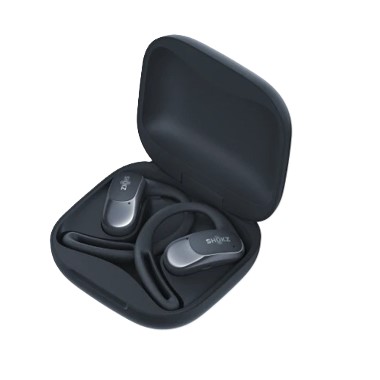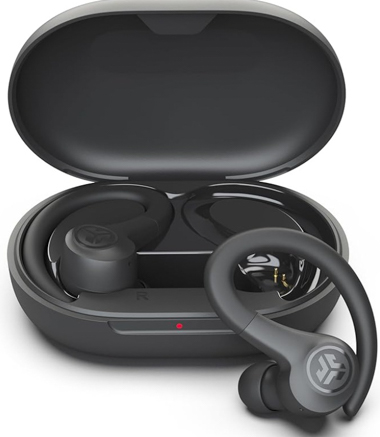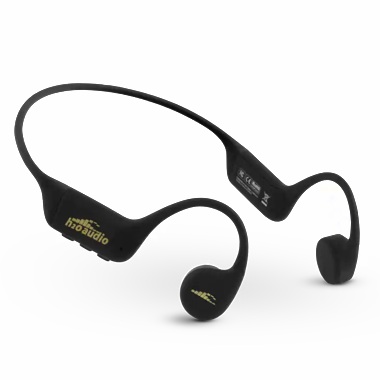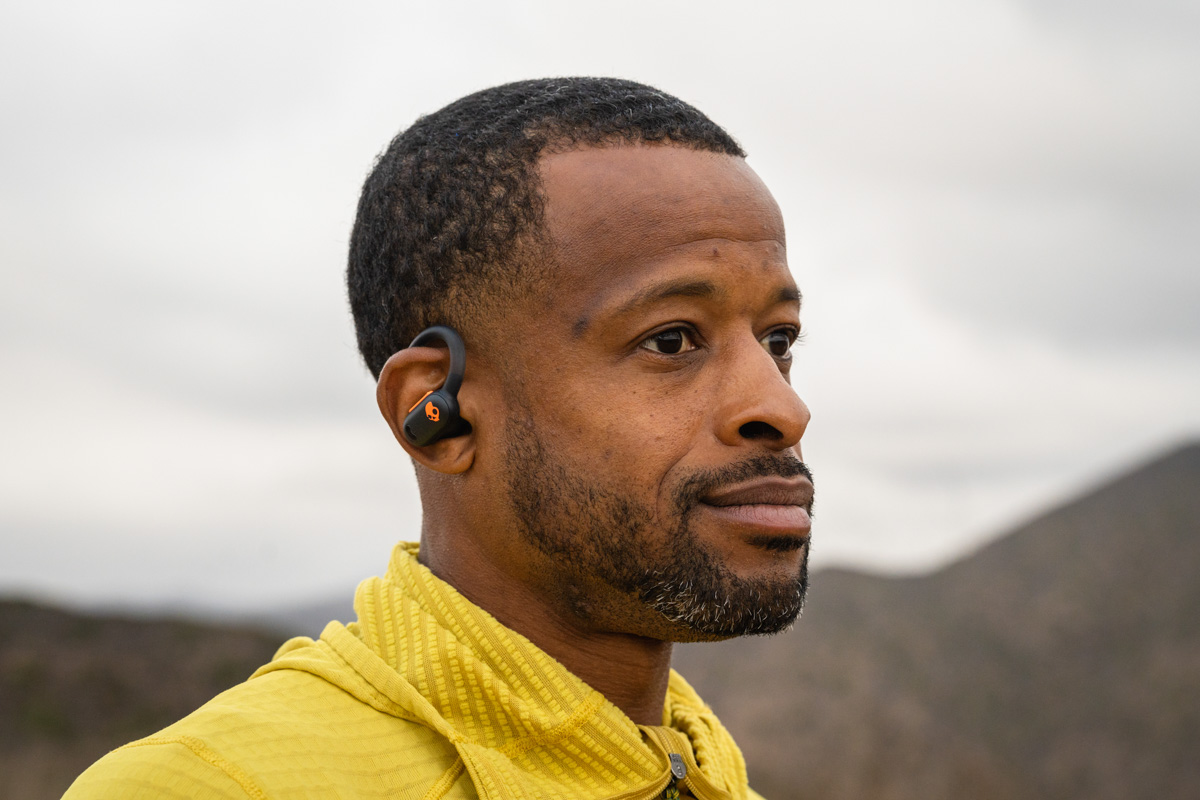
The iRunFar team named the Apple AirPods Pro the best running headphones. Photo: iRunFar/Eszter Horanyi
While headphones can be a surprisingly contentious topic in the running world, if you enjoy listening to music or a podcast during a run, you’ll want to find the best running headphones for your ears. Listening to music or podcasts on a run can be an excellent way to break up the monotony of training and learn something new; many of us swear by having our earbuds in. For others, running can be an important time of quiet meditation.
Either way, being present and aware of your surroundings is important for safety. The iRunFar team tested over a dozen headphones and earbuds for several months to determine the best running headphones for every budget. Ultimately, we kept returning to our favorites, the Apple AirPods Pro 3. Open-ear headphones are gaining traction amongst runners, and we found that the Shokz OpenFit Air were a great option. Bone-conduction headphones are gaining increasing traction in the market, and we were impressed by the sound quality of the Shokz OpenRun Pro 2.
Take a more detailed look at our picks below and browse our How to Choose, Frequently Asked Questions, and Methodology sections to learn more about picking out the best running headphones for you.
Best Running Headphones
- Best Overall Running Headphones: Apple AirPods Pro 3
- Best Overall Running Headphones — Runners-Up: JBL Endurance Peak 3 and Skullcandy Push ANC Active
- Best Bone-Conduction Running Headphones: Shokz OpenRun Pro 2
- Best Open-Ear Running Headphones: Shokz OpenFit Air
- Best Budget Running Headphones: JLab Go Sport+
- Best Waterproof Running Headphones: H2O Audio Tri 2 Pro
Best Overall Running Headphones: Apple AirPods Pro 3 ($250)
- Comfortable and secure earpieces
- Noise-canceling mode is awesome, and has gotten even better!
- Excellent sound for music
Cons:
- Podcasts don’t sound great
We admit that choosing the Apple AirPods Pro 3 as our top headphones feels a bit cliche. However, we also acknowledge that they’re excellent earbuds, ideal for running, and we kept coming back to them, regardless of how many other options we tried. They’re expensive.
Yet, the AirPod Pro 3 once again features improved active noise cancellation (ANC) technology — something we enjoyed, whether running with them, using them on a plane, or while working in a coffee shop. The touch control is extremely handy, and while the (once again) improved eight hours of battery life in ANC mode is better than the previous model. Still, the ultrarunners in our crew, would still like to see that time lengthen even further for our longest runs.
If you’re also like us, you’re probably concerned about how securely they fit in your ear while running and the potential for them to fall out during a trail run and get lost. While other earbuds we tested did feel a bit more secure, we had no issues with these falling out, even during a couple of hard falls, and the 3rd gen lives up to the standard set by its predecessors. These earbuds are pricey, but we believe they are the best running ones available and worth the investment.
Shop the Apple AirPods Pro 3Best Overall Running Headphones — Runner-Up: JBL Endurance Peak 3 ($110)
- Good sound quality
- Great value
- Solid waterproofing
Cons:
- The case and actual headphones are a bit bulky
We love the JBL Endurance Peak 3 as a middle-of-the-road pair of earbuds. They offer good sound quality for most people, a comfortable over-ear fit, and solid waterproofing. At nearly half the price of the Apple AirPods Pro, they provide an excellent value and are a good choice for someone who doesn’t want a top-end or budget set of headphones. JBL claims the headphones have 10 hours of playtime and an additional 40 hours of charging in the case.
These headphones don’t have active or adaptive noise canceling, but they do have an Ambient Aware mode that allows you to hear surrounding noise. Everyone has been caught behind someone on a trail who has their music on too loud or in noise-canceling mode and can’t hear you when you want to pass. We recommend keeping music volume relatively low when running outdoors to remain situationally aware.
You can customize your listening experience using an app associated with these headphones. Our one issue with these earbuds is that they’re a bit bulkier and less comfortable than others on the list.
Shop the JBL Endurance Peak 3Best Overall Running Headphones — Runner-Up: Skullcandy Push ANC Active ($105)
- Good value
- Long battery life
- Rapid charging
Cons:
- The on/off button is very sensitive
The Skullcandy Push ANC Active is a solid set of headphones at a reasonable price point. The earbuds are comfortable, and the over-the-ear hook provides a bit of extra security to keep them in place. While these headphones have several features specifically designed for running, such as being sweat- and waterproof, we also found ourselves using them as our everyday headphones due to their Active Noise Canceling (ANC) technology.
The ANC can be turned on and off depending on your situation, and there’s also a Stay Aware mode that allows you to hear ambient noise even when audio is playing. The ANC also has multiple levels you can set depending on how much you want to tune out ambient noise. The app allows you to control the levels, while you can also turn the ANC on and off directly on the headphones. We found that the full noise-canceling mode made everything sound a bit echo-y while running, so we generally used Stay Aware mode or the lowest level of ANC. For coffee shops or airplanes, the full ANC is quite effective.
The on-headphone controls are straightforward to use, although we found the skull logo, which serves as the play and pause button, to be sensitive enough that we would accidentally turn our music on and off just by brushing it lightly.
With a seven-hour battery life and Active Noise Cancellation (ANC) enabled, these headphones will last through most runs. They rapidly charge in their case, which holds an additional 30 hours of charge. To extend the headphones’ lifespan, turn the ANC off and get 12 hours of use from the earbuds, plus an extra 46 hours in the case.
As with all headphones these days, you can use these to make phone calls, and we found both the incoming and outgoing audio to be of good quality.
Shop the Skullcandy Push ANC ActiveBest Bone-Conduction Running Headphones: Shokz OpenRun Pro 2 ($180)
- Good battery life
- Easy to use
- Quality sound
- Secure fit
Cons:
- Bone conduction/open ear isn’t a very versatile option
The Shokz OpenRun Pro 2 headphones utilize bone conduction technology to transfer sound directly to the inner ear through vibration, making them an excellent option for headphones that don’t cover or go inside your ear. We’ve used multiple versions of these headphones and found that they continue to improve.
The upgraded fit doesn’t bounce or shift, although the part of the headphones that goes around the back of the head does protrude slightly. This was only a problem for our long-haired testers who wanted to wear their hair down. It didn’t quite feel right wearing hair over or under the back wire. That said, with short hair or a ponytail, the fit of these headphones is excellent. They’re super convenient to drop around your neck when you don’t want to wear them, and you don’t have to worry about them falling off and disappearing into the grass or dirt like tiny earbuds.
While we love the simplicity of bone conduction headphones — it is much easier to be aware of your surroundings when running — they’re not very practical or versatile outside of using them when active. While you can still listen to music or a podcast wherever you are, you won’t be able to cancel ambient sound while working in a loud coffee shop or on an airplane.
Shop the Shokz OpenRun Pro 2Best Open-Ear Running Headphones: Shokz OpenFit Air ($120)
- Incredibly light
- Allows for good situational awareness
Cons:
- Not noise-canceling
- Changing tracks is finicky
- Lower battery life
It’s tempting to choose the Shokz OpenFit Air headphones as the best overall running headphones, and if we weren’t considering headphones’ versatility in our rankings, we might just do so. However, we recognize that most people prefer not to own multiple pairs of headphones. As a result, the fact that these are open-ear headphones without noise-canceling capabilities limits their usefulness in many everyday situations. And they also don’t work in the rain or if they get too damp from sweat. That said, for running in dry climates, they are outstanding.
There are two main types of open-ear headphones: ones like these that sit on the outside of the ear and use vibrational waves in the air to transfer sound without a bud inside your ear, and bone-conduction headphones, like the Shokz OpenRun Pro 2 reviewed above, that transmit the vibration directly to the bones in your ear via your cheekbones. Both of these styles of headphones keep your ears open, allowing you to hear what’s going on around you, a key feature when running on trails and roads with other people nearby.
The sound quality of these headphones is comparable to other higher-end options on this list, but what sets them apart is their exceptional comfort. They weigh nothing. Well, they weigh nine grams each, but we’ve repeatedly found ourselves double-checking that the headphones are still on our ears while out running. The sound is there, but often, we can’t actually feel whether there’s a headphone on our ear or not. Our main tester may have kept them on her ears unknowingly for hours after the battery died while she was writing gear reviews one day.
The over-the-ear hook keeps the headphones secure, and they have stayed in place while running on various terrains, as well as while mountain biking. Our tester also appreciated that she didn’t have to keep her hair in a ponytail for these headphones to fit, which was something that bothered her with the Shokz OpenRun Pro 2 bone-conduction headphones above, as they didn’t fit well on top of or under unsecured hair.
The main issue with these headphones is that the controls become impossibly sensitive when they get wet, whether you’re running in the rain or just sweating. This makes them a dry-climate-only set of headphones. That’s not the end of the issues with the controls, either. Changing tracks is a bit fiddly with single, double, and triple taps of a button that doesn’t physically compress. These headphones work for users who want to have their playlist curated beforehand, so they can enjoy their music uninterrupted. Adjusting the volume is a bit easier, but not as intuitive or as easy as with other headphones. Additionally, they don’t automatically turn off when you remove them from your ears, which can lead to the battery unintentionally draining if you’re not careful. They do turn off when you put them in their case.
These headphones hold about six hours of charge, which is enough for most runs but not enough if you’re planning to do an ultra with them. They charge quickly once in their case and can gain two hours of charge in just 10 minutes, fully charging in just one hour. The case holds an additional 28 hours of charge.
If you’re someone who runs in dry climates and puts headphone comfort as a top priority, these are hard to beat.
To learn more, read our in-depth Shokz OpenFit Air review.
Shop the Shokz OpenFit AirBest Budget Running Headphones: JLab Go Sport+ ($30)
- Excellent earbuds for the price
- Over-ear hooks are soft and feel secure
- Includes three different earbud sizes
Cons:
- Sound quality is less than higher-end options
If you don’t wear earbuds often or just want a budget option, you’ll love the JLab Go Sport+ earbuds. First, for $30, you really can’t beat the value. We especially liked the over-ear hooks, which are soft and feel secure. The three additional earbud sizes help boost security and fit. Tap controls make it easy to make calls on Siri or Google, and you can also use voice command instructions to answer and hang up calls. It’s a small detail, but we like that the charging cord is built into the charging case so it doesn’t get lost.
The Bluetooth connection was quick and easy to use. The device features a “Be Aware” mode to increase situational awareness while running. While quality can be a concern with budget options, these come with a two-year warranty if anything goes wrong.
Shop the JLab Go Sport+Best Waterproof Running Headphones: H2O Audio Tri 2 Pro ($200)
- Wearable while swimming
- Able to load music directly to the headphones, but the process was a bit cumbersome
Cons:
- Bulkier and heavier than other headphones
We understand that many runners partake in other sports, and if you happen to be a swimmer as well, the H2O Audio Tri 2 Pro headphones are an excellent option for both sports. They are a bone-conduction model of headphones, and while they are a bit bulkier and heavier than some of the other options that we tested, they were still comfortable and secure.
The extra bulk is most likely due to the onboard music storage, a feature that sets this set of headphones apart from the rest included in this guide. You can actually load music and podcasts onto the earbuds via Spotify or MP3 files and listen without needing your phone. The loading process from Spotify wasn’t straightforward, but we eventually figured it out. This feature benefits swimmers who want to listen to music without having to keep their phones nearby. If you’re a runner who doesn’t like to carry a phone but still wants to listen to music or a podcast, these are a great option.
Shop the H2O Audio Tri 2 ProComparing the Best Running Headphones
| HEADPHONES | PRICE | BATTERY LIFE | NOISE CANCELLATION | TYPE |
| Apple AirPods Pro 3 | $250 | 8 hours | Yes | In-ear |
| JBL Endurance Peak 3 | $110 | 10 hours | No | Wrap |
| Skullcandy Push ANC Active | $105 | 7 hours | Yes | Wrap |
| Shokz OpenRun Pro 2 | $180 | 10 hours | No | Bone conduction |
| Shokz OpenFit Air | $120 | 6 hours | No | Open |
| JLab Go Sport+ | $30 | 9 hours | Yes | In-ear |
| H2O Audio Tri 2 Pro | $200 | 9 hours | No | Bone conduction |
How to Choose the Best Running Headphones
Styles of Headphones
The options for the best running headphones are as varied as the type of audio entertainment available for listening. There are four main types of headphones: those that go over your ears, those that go in your ears, open-ear headphones like the Shokz OpenFit Air, and bone-conduction headphones, such as the Shokz OpenRun Pro 2, which sit adjacent to the ear and transmit vibrations directly to it.
You may see runners with anything from over-ear headphones that look like they’ve come straight out of a DJ booth to those with tiny little buds that fit almost invisibly into the ear. Most runners opt for in-ear headphones, such as the Apple AirPods Pro 3, due to their lightweight design and ease of use. Within this category, you can find headphones that fit comfortably into your ear without any additional attachments, those that clip on over your ear, and those that have both earbuds attached, making them easier to keep track of.

Open-ear bone-conduction headphones allow you to hear noises around you while still listening to audio. Photo: iRunFar/Eszter Horanyi
Headphones can be either corded or wireless, with the latter operating via Bluetooth. Most people have moved away from headphones with cords for running, except for those who require a longer listening time that wireless headphones cannot provide. This way, you only have to worry about your phone battery, not your headphones’ battery. Even long-lasting Bluetooth headphones won’t get you through a long ultra if you’re listening continuously.
You can also choose between noise-canceling headphones that block out ambient noises and those that allow you to hear what is happening around you. Open-ear headphones, such as the Shokz OpenFit Air, make it easy to enjoy high-quality audio while still hearing surrounding noise.
Types of Headphones to Use While Running
Choosing the best headphones for running largely depends on personal preference and budget. Some may prefer over-ear headphones, while others opt for buds that fit inside the ear. Some might want wireless Bluetooth headphones, while others might prefer a cord that attaches to their phone. Some might prefer noise-canceling earbuds, while others prefer to hear at least portions of their surroundings. Bone-conduction headphones, such as the Shokz OpenRun Pro 2, are becoming increasingly popular because they allow you to listen to noises around you, whether that’s a car approaching from behind or another trail user wanting to pass.
We generally choose Bluetooth earbuds as the best running headphones because they’re lightweight and don’t have a cord that can get in the way or be annoying while running. Since it’s essential to be aware of your surroundings when running, we recommend using earbuds with adjustable noise-canceling levels, such as the Skullcandy Push ANC Active, or opting for earbuds with no noise-canceling features, like the Shokz OpenFit Air.
Knowing what’s happening around you is important, whether running on trails, roads, or a bike path. If your earbuds are noise-canceling, we recommend wearing just one so one ear is open. You’ll want to have the volume low enough to hear if someone has come up behind you and wants to pass.
Adjustability and Fit
As with all pieces of gear, you want headphones or earbuds that are comfortable to wear. While there are different ear shapes and sizes, most headphones will fit most people.
In-ear headphones are placed relatively deep inside the ear to stay in place and have limited adjustability. However, some have an extra hook that goes over the top of your ear. The JLab Go Sport+ will come with a few differently sized earbud covers, allowing you to make slight adjustments in the fit. More than anything, you don’t want your headphones or earbuds falling off while running and jostling, so a snug fit tends to be better.

The wrap-around securement style of the Shokz OpenFit Air keeps them in place while running. Photo: iRunFar/Eszter Horanyi
Wireless Versus Wired Headphones for Running
While wired headphones were the only option for a long time, most runners have migrated to wireless in recent years. Not having to deal with a cord between your phone and earbuds makes it easier to store your phone in a pack or carry it in your hand without worrying about getting tangled up.
Still, wired headphones have their place. Since they don’t have their own separate battery, you don’t have to worry about keeping them charged. This is especially useful if you’re running an ultra that exceeds the battery life of Bluetooth headphones. You can carry your phone with an external battery and listen to music to your heart’s content. However, for most users, the 10-hour battery life of earbuds like the Shokz OpenRun Pro 2 will be more than sufficient.
Bluetooth Headphone Battery Life and Charging
The average battery of most Bluetooth headphones provides five to six hours of listening time. This will get the majority of people through most of their runs. If you regularly run longer than this and want reliable music for the entire duration, you’ll want a higher-end set of Bluetooth headphones with longer battery life. The 10-hour battery life of the JBL Endurance Peak 3 and Shokz OpenRun Pro 2 are on the higher end of the battery range. Alternatively, opt for the tried-and-true corded headphones that will run off your phone’s battery. To help keep headphones charged, turning them off after use is important, and placing them in their case to be topped off can ensure you head out on each run with a full charge.
Noise-Canceling Headphones
One of the newer innovations with headphones is their ability to cancel ambient sounds. While this technology was initially available only on high-end, large, over-the-ear headphones, earbuds also now boast this technology. Noise-canceling headphones are excellent in certain situations, such as airplanes and other places where you want to tune out the outside world, but they’re not always the best for running.
Hearing your surroundings is essential for both trail running and road running. On the road, you’ll want to be able to hear cars coming up behind you. When running on a trail, it’s crucial to have situational awareness to hear other trail users approaching, especially mountain bikers who are moving fast but generally make a fair amount of noise. Most trail users have had at least one frustrating experience of trying to pass someone with headphones in and cranked up who won’t move out of the way. Don’t be that person.
If you want to wear noise-canceling headphones, consider running with just one earbud so that you can hear and respond to your surroundings. The Shokz OpenFit Air lacks noise-canceling capabilities, making it a suitable option for individuals who want to remain aware of their surroundings while running. Bone-conduction headphones — like the Shokz OpenRun Pro 2 — are also great for situational awareness.

Earbuds will stay securely in most ears and are a light and compact option. Photo: iRunFar/Eszter Horanyi
Water and Sweat Resistance
While some headphones specifically designed for swimmers, like the H2O Audio Tri 2 Pro, are fully waterproof, most options that appeal to runners are merely water resistant. This means they’ll withstand a sprinkling of rain or a dousing of sweat, but they won’t survive a full dunking in a river or a trip through your washing machine.
Sound Quality
When it comes to sound quality, you generally get what you pay for. Most of the best running headphones are small, compact, lightweight, and offer reasonable sound quality, which is generally more than enough for most people to enjoy listening to music, podcasts, or audiobooks during a run.
If you’re looking for the best sound quality in headphones small enough for running, it’s tough to go wrong with the Apple AirPods Pro 3. If you’re a music aficionado who values exceptional sound quality, you’ll likely want a pair of high-quality over-ear headphones for home use and a second pair that you reserve exclusively for running.
Built-In Microphones
Most headphones on the market come with a built-in microphone that allows you to make phone calls or communicate with your device. While most runners don’t use this feature during runs, unless dialing in on a work Zoom call on mute and pretending to be in the office, it could come in handy if you just need to answer a quick call or send a voice text. We found the Skullcandy Push ANC Active microphone allowed for phone conversations while out on the trail.
In-Ear and Open-Ear Versus Over-Ear Headphones
While most runners opt for in-ear or over-ear headphones due to their weight, comfort, and compactness, some prefer over-ear or on-ear headphones. In-ear headphones fit into the ear, and while the speaker location in this headphone style can vary, they all fit similarly. Some in-ear headphones, like the JLab Go Sport+, feature an additional attachment system that wraps over the top of the ear to help secure the bud in place inside your ear. Other headphones will slot securely into the ear without any extra material. Open-ear headphones, such as the Shokz OpenFit Air, fit like in-ear headphones with an attachment system, but without the earbud inside your ear.
Over-ear and on-ear headphones are commonly associated with DJs or those working at a desk who want to send a clear message that they don’t want to be disturbed. They’re larger and fit over and around the entire ear. These headphones tend to have better sound quality, but they are also cumbersome. Still, some people love running with them.

The iRunFar team appreciated the fit and sound quality of the Apple AirPods Pro earbuds. Photo: iRunFar/Eszter Horanyi
Compatibility with Devices
While most headphones will work with most phones, there are a few compatibility issues that are good to be aware of. If you have an Apple phone, you can use Apple AirPods Pro 3 to listen, talk, and control Alexa. They will also work with an Android phone to listen to music and talk, but you won’t be able to use Siri. If you’re about to purchase a set of corded headphones, you’ll want to ensure that your phone has an actual headphone port, as many modern phones have entirely done away with this feature.
Durability
Most in-ear headphones will last several years if taken care of. Even with the best care, wires will work loose in many headphones, rendering one or both earbuds useless. As with most products, paying more for headphones generally means they will last longer. If you tend to lose small items like headphones, buying a less expensive pair, such as the $30 JLab Go Sport+ headphones, could be a good idea to minimize the replacement cost when they inevitably get misplaced.
Safety Features
While most headphones have volumes that can reach about 100 decibels, keeping them below 70 decibels is recommended to prevent damage to your hearing. Generally speaking, if you’re keeping the volume low enough to hear noises around you, which we highly recommend for safety, then you’re not in a volume range that could cause damage to your ears. Some devices allow you to set a maximum volume, preventing you from inadvertently turning them up too high. Bone conduction headphones, such as the Shokz OpenRun Pro 2, can also help minimize potential damage to your ears.
If you’re concerned about hearing damage, over-ear headphones are generally better for your ear health since the speaker is positioned farther away from your eardrum. Taking breaks from listening to music after an hour is also recommended to give your ears a chance to recover.
Why You Should Trust Us
We began this guide by conducting extensive research into the world of headphones, compiling a list of over forty options specifically designed for running and sports on the market today. We narrowed this list to some top choices in several different categories and spent several months using them in various settings to find the best running headphones in each category. We logged hours of trail and road running, as well as daily “real-life” use, to determine which rose to the top in terms of sound quality, safety, noise-canceling capabilities, comfort, and battery life, to create our list of favorite headphones.
We continue to use headphones from this list to identify any durability issues while testing new ones on the market. This guide is updated regularly with new products as we discover something exceptional.
Frequently Asked Questions about the Best Running Headphones
What is the difference between regular headphones and running or sports headphones?
Running or sports headphones are generally lightweight, water- and sweat-resistant, and designed to stay securely in place in the ear. Many sport-oriented headphones also feature longer battery life, allowing you to take them on longer runs. They’ll have a streamlined and secure fit to stay in your ear while you’re running and jostling them. Sport-oriented headphones are also more likely to have materials that won’t absorb odors or sustain damage from sweat. Most runners opt for wireless headphones to avoid dealing with a tangled cord. While many headphones, such as the Apple AirPods Pro 3, are great for both running and casual use, open-ear headphones like the Shokz OpenFit Air, which lack noise-canceling technology, are specifically designed for use in a sports setting.
What’s the best style of headphones?
While it comes down to personal preference, most runners prefer earbuds or open-ear headphones to over-ear headphones because they are lighter, less cumbersome, and tend to stay in place better. However, some people dislike the feel of in-ear devices. Bone conduction headphones, such as the H2O Audio Tri 2 Pro, are gaining popularity because they enable you to hear your surroundings while listening to audio. The Shokz OpenFit Air also leaves your ear open, but it doesn’t utilize bone-conduction technology.

Bone conduction headphones, such as the Shokz OpenRun Pro, can help runners stay aware of their surroundings. Photo: iRunFar/Eszter Horanyi
Are running headphones waterproof?
Most sports or running headphones and earbuds are water-resistant, but not waterproof. While they’ll withstand sweat or light precipitation, we do not recommend submerging your earbuds in water. It’s also a good idea to put most pairs away if it starts to rain heavily. Some headphones or earbuds, such as the H2O Audio Tri 2 Pro, are specifically designed for swimming and are completely waterproof. If you frequently run in the rain or swim as a form of cross-training, it may be worth investing in a pair of fully waterproof headphones, such as the JBL Endurance Peak 3 or the Skullcandy Push ANC Active.
What is an IP rating for running headphones?
IP stands for Ingress Protection and is a rating system assessing the waterproofness of a product. An IP rating, which the International Electrotechnical Commission assigns, typically consists of an IP designation followed by two numbers, such as IP37. The first number represents a product’s rating against solid materials, such as dust, on a scale of one to six. The second digit represents its waterproof rating on a scale of one to eight. The higher the number, the more waterproof it is. If there is an “X” in the rating, such as IPX7, there is no solids rating. The Apple AirPods Pro 3 has an IPX4 rating and is considered safe from splashes of water and sweat.
How do bone-conduction headphones work?
Bone conduction headphones, such as the H2O Audio Tri 2 Pro and the Shokz OpenRun Pro 2, rest on your cheekbones instead of in your ears. Instead of sound waves vibrating through the air and into your eardrums, they vibrate and pass sound waves directly through your skull bones into your ear bones. This technology enables you to listen to audio without covering or blocking your ears. Bone conduction headphones are an excellent option for anyone wanting to listen to audio while keeping their ears open for situational awareness. This is different technology from the Shokz OpenFit Air, which are open-ear headphones but not bone-conduction headphones.
Can wireless headphones be charged on the go?
You can’t use most wireless headphones while they’re charging, which limits their usefulness for long runs where you want continuous music. If you’re worried about taking your headphones off to charge them during a run, consider getting a set of corded headphones that can run off your phone’s battery. Most earbuds, such as the Apple AirPods Pro 3, charge while stored in their cases. The Skullcandy Push ANC Active charges quite rapidly when in their case, and you won’t have to wait long before you can start using them again. Other headphones, such as the Shokz OpenRun Pro 2, charge with a USB cord plugged into a wall outlet, laptop, or car charger.

Wrap-around earbuds offer an added layer of security to keep everything in place. Photo: iRunFar/Eszter Horanyi
How can I safely wear headphones while still being aware of my surroundings?
Being aware of your surroundings while running is always a good idea. That’s why we don’t recommend running with noise-canceling headphones unless you have the option to make them not fully noise-canceling or are willing to leave one earbud out. The Skullcandy Push ANC Active has noise-canceling adjustability, making it a versatile option for running and everyday use. Bone-conduction headphones, such as the Shokz OpenRun Pro 2, also enable situational awareness, as do open-ear headphones like the Shokz OpenFit Air.
We wouldn’t recommend over-the-ear noise-canceling headphones for running because they make it hard to keep track of sounds around you. Knowing what’s happening around you is important to staying safe while running.

The Shokz OpenFit Air are open-ear headphones and don’t have a bud that goes inside your ear, making them great for situational awareness. Photo: iRunFar/Eszter Horanyi
What is Active Noise Canceling technology?
Noise-canceling technology generally comes in two forms — active and passive. Passive is the simpler of the two and includes using ear cups to seal out background noise. Active noise canceling is more complicated as it uses microphones and speakers to eliminate background noise. Over-the-ear headphones traditionally feature active noise canceling (ANC) technology, but the technology has advanced for earbuds. Nowadays, earbuds like the Skullcandy Push ANC Active will include adjustable active noise canceling technology, meaning you can adjust just how much ambient noise to cancel.
How do wireless headphones connect to my devices?
Wireless headphones connect to devices via Bluetooth. When you first set up your headphones, you will need to pair them. After connecting them once, you should have minimal issues connecting them in the future. Most headphones will work with all devices, but the Apple AirPods Pro 3 has limited compatibility with Android phones.
Are headphones and earbuds one-size-fits-all?
Most headphones come in one size, but they’ll be adjustable. While most earbuds are one-size-fits-all, the JLab Go Sport+ earbuds come with replacement pieces of different sizes to fit various ear sizes.
Call for Comments
- Do you frequently run in headphones?
- What are your favorite headphones for running?

